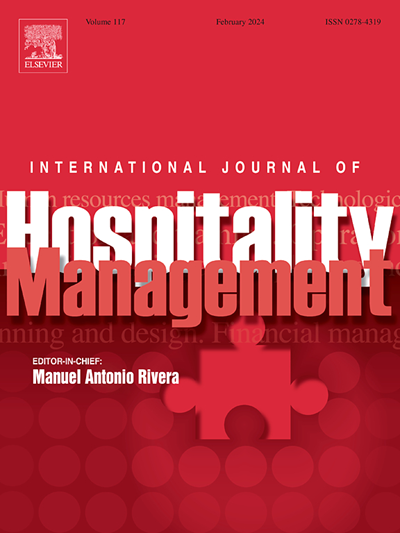Food and wine resources as co-experiential attributes: A qualitative investigation across eight countries
IF 9.9
1区 管理学
Q1 HOSPITALITY, LEISURE, SPORT & TOURISM
International Journal of Hospitality Management
Pub Date : 2025-05-13
DOI:10.1016/j.ijhm.2025.104237
引用次数: 0
Abstract
This study examines the amalgamation of food and wine based on the importance of a) star dishes, b) star wines and c) how gastronomy could play a stronger role in the winery experience. Embracing the notions of the resource-based view and experience co-creation, the perspectives of 142 winery owners and managers operating in five established and three developing wine-producing nations were gathered through semi-structured, open-ended interviews. The qualitative analysis revealed multiple overarching dimensions. For instance, ‘gastronomic inventory’ and ‘gastronomic niche’ underline the multiplicity of gastronomic offerings and representations of uniqueness, respectively. Similarly, the ‘distinctive and intrinsic product resources’ illustrate the diversity of wine products and their unique and historical attributes, while the ‘stimulating gastronomy’s pull’ suggests accentuating the interest in local foods and wines. Differences between established and developing wine-producing regions were also uncovered. A conceptual framework that further deepens the data analysis and its associated implications is proposed.
食品和葡萄酒资源作为共同体验属性:一项跨越八个国家的定性调查
本研究基于a)星级菜肴,b)星级葡萄酒和c)美食如何在酒庄体验中发挥更大作用的重要性来研究食物和葡萄酒的融合。采用资源为基础的观点和经验共同创造的概念,通过半结构化的开放式访谈,收集了来自五个成熟葡萄酒生产国和三个发展中葡萄酒生产国的142个酒庄老板和经理的观点。定性分析揭示了多个总体维度。例如,“美食库存”和“美食利基”分别强调了美食产品的多样性和独特性。同样,“独特和固有的产品资源”说明了葡萄酒产品的多样性及其独特的历史属性,而“刺激的美食的吸引力”则表明强调了对当地食品和葡萄酒的兴趣。研究还揭示了老牌葡萄酒产区和发展中葡萄酒产区之间的差异。提出了一个进一步深化数据分析及其相关含义的概念框架。
本文章由计算机程序翻译,如有差异,请以英文原文为准。
求助全文
约1分钟内获得全文
求助全文
来源期刊

International Journal of Hospitality Management
HOSPITALITY, LEISURE, SPORT & TOURISM-
CiteScore
21.20
自引率
9.40%
发文量
218
审稿时长
85 days
期刊介绍:
The International Journal of Hospitality Management serves as a platform for discussing significant trends and advancements in various disciplines related to the hospitality industry. The publication covers a wide range of topics, including human resources management, consumer behavior and marketing, business forecasting and applied economics, operational management, strategic management, financial management, planning and design, information technology and e-commerce, training and development, technological developments, and national and international legislation.
In addition to covering these topics, the journal features research papers, state-of-the-art reviews, and analyses of business practices within the hospitality industry. It aims to provide readers with valuable insights and knowledge in order to advance research and improve practices in the field.
The journal is also indexed and abstracted in various databases, including the Journal of Travel Research, PIRA, Academic Journal Guide, Documentation Touristique, Leisure, Recreation and Tourism Abstracts, Lodging and Restaurant Index, Scopus, CIRET, and the Social Sciences Citation Index. This ensures that the journal's content is widely accessible and discoverable by researchers and practitioners in the hospitality field.
 求助内容:
求助内容: 应助结果提醒方式:
应助结果提醒方式:


